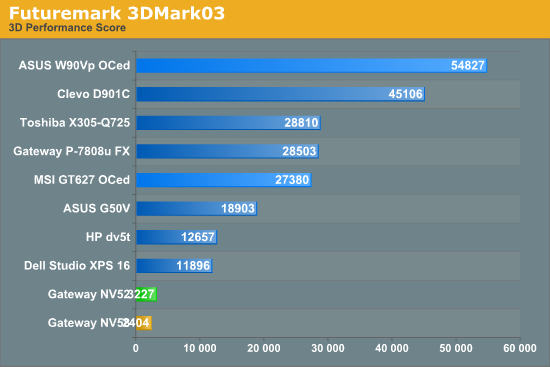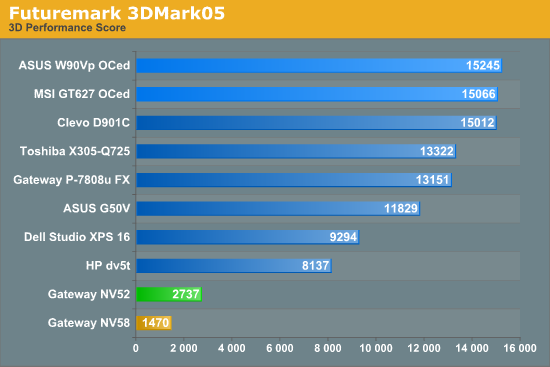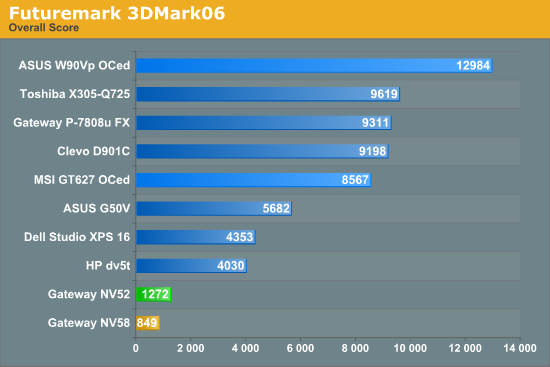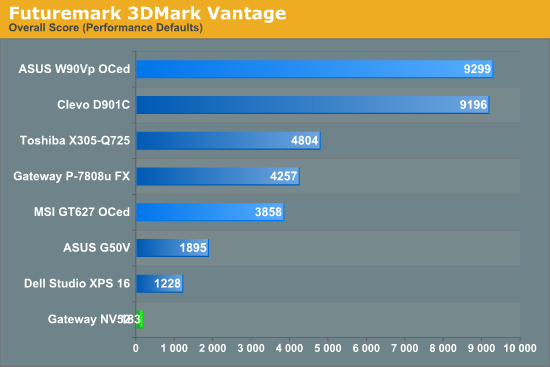Gateway AMD and Intel Laptops, a Platform Analysis
by Jarred Walton on August 12, 2009 2:00 AM EST- Posted in
- Laptops
Synthetic Graphics Performance




We didn't run most of our gaming tests at higher resolution/quality settings, since performance was abysmal. 3DMark certainly isn't the final say in gaming performance, but it does give you a good reference point. The "slowest" laptops we have with discrete graphics are the HP dv5t (GeForce 9600M GT 512MB) and the Dell Studio XPS 16 (Mobility Radeon HD 3670 512MB). Both end up being more than three times as fast as the NV52 and it's HD 3200. Note that the NV58 failed to run the "Performance" setting in 3DMark Vantage, so it's not present in that chart.










67 Comments
View All Comments
strikeback03 - Thursday, August 13, 2009 - link
"Again, what percentage of laptop users actually play 3D games on a regular basis - or at all?"Doesn't mean that no users play 3D games, it means that the majority never do, some small percentage play infrequently, and some smaller percentage would regularly.
Also, an AMD blog is probably not the best place to look for a balanced view of an AMD/Intel comparison.
flipmode - Wednesday, August 12, 2009 - link
AMD's mobile products have always been rebranded desktop products - which have always been rebranded server products. In the best cases, the CPUs run at lower voltages and lower speeds.Intel has, interesting, done the opposite, as far as I can tell. They designed the Pentium M from the ground up for mobile, and turned that into Core 2 for the desktop, and turned that into Nahalem for the server.
This is all in spite of the fact that several years ago, AMD stated that it was placing mobile above desktop in terms of importance. But technology has a natural flow between the two poles of server and mobile, with desktop stuck in the middle. AMD chose to flow from high to low, Intel chose to flow from low to high. It seems that Intel's choice was the better one.
blackshard - Wednesday, August 12, 2009 - link
Approximately it is true, but consider that these 65nm mobile AMD parts have absolutely no correspondence in desktop market. These are Family 11h processors and are a mixture of old K8 (execution units) and newer K10 processors (memory controller, power management).Actually Athlon QLs is the least attractive from a performance and power management point of view. I hope Walton will get some ZM/RM processors from AMD to make a clear comparison.
mircix - Wednesday, August 12, 2009 - link
Ok. Great article and I have a simple question. I am interested mostly in Avid, witch is a professional video editing software, and 3ds max. 3ds for movie CGI. I'm not looking for a desktop's working station performace, but something decent. I've runned 3ds 2009 on a 1.6 gh and intel gms 950, hp pavilion dv100 and works. but slow. So, for closure: 3ds max and Avid : AMD or Intel? Thank youjamawass - Wednesday, August 12, 2009 - link
Although the conclusions of the article are correct, the graphical charts for gaming comparisons are sneakily designed to minimize the tremendous advantage AMD has in gaming performance over Intel. If this performance is as unimportant as the author states ( Kia vs Hyundai) why not represent it in bar chart form like all the other results? As another poster said, testing games like the Sims or WoW would be much more meaningful on these platforms than FPS.I don't think anyone buys a laptop of this price for gaming but I've owned an AMD one like it and on overseas trips I would take FarCry along and fire it up for some casual gaming something I wouldn't be able to do on a similarly spec'd Intel laptop.
We know Intel has the superior mobile design but objectivity would be nice so independent decisions can be made as to how important gaming is to a potential buyer.
IHateMyJob2004 - Wednesday, August 12, 2009 - link
I really want a laptop for wordprocessing. All I want is a cheaper (processing power not needed) laptop with a high resolution. 1920x1200 is what I want but this also seem to be a segment that Every manufacturer is ignoring. This is how a utilitarian wants to use alaptop and I'm sure I am not the only one out there.And I agree with what you said. Unelss the primary use for a laptop is games and movie watching, the 16:9 and 16:10 ratio screen is stupid. Widescrees are in, but I view them as short screens. And short screen suck for word processing and software develeopment. Give me a 5:3 ratio screen! Bring them back!
The only thing I am really curious about in terms of performance is how much better a low cost laptop is if it has a dedicated viddeo card with its own memory versus a laptop where the video card uses system memory. I'm mostly concerned with any lag that is associated with the video card due to how it uses memory.
strikeback03 - Thursday, August 13, 2009 - link
See, plenty of people like the widescreens for writing tasks, as you can have 2 800px columns of text on a 1920px screen side by side. I don't like the current move to 16:9 from 16:10 though, that is obviously a step back.mczak - Wednesday, August 12, 2009 - link
This article clearly shows that AMD desperately needs updated mobile platform (Tigris). In terms of chipset won't be much of an update (rs880m/sb710) but finally 45nm cpu (Caspian - probably same as regor for mobile market). Won't be enough to close the gap (those 65nm Athlons didn't do too well against 65nm C2D neither) but at least something more competitive (so together with the price advantage and better graphics maybe a competitive package).mczak - Wednesday, August 12, 2009 - link
forgot to mention, that platform better show up soon. Against Intel's Calpella platform (with Arrendale cpu) it will look quite bad I assume, and even the graphics advantage could disappear. Fortunately for AMD, Arrendale shouldn't show up before 2010, though that's not that much time left...weeaboo - Wednesday, August 12, 2009 - link
I don't play it personally, but I imagine that one of the most common game people play on their non-gaming laptop is World of Warcraft. On this kind of platform I think performance figures on the MMOs of yesteryear would be more interesting than a plethora of FPS games.